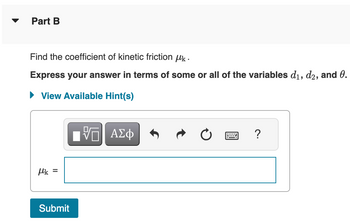Learning Goal: A sled is being held at rest on a slope that makes an angle with the horizontal. After the sled is released, it slides a distance di down the slope and then covers the distance de along the horizontal terrain before stopping. Find the coefficient of kinetic friction between the sled and the ground, assuming that it is constant throughout the trip.
Learning Goal: A sled is being held at rest on a slope that makes an angle with the horizontal. After the sled is released, it slides a distance di down the slope and then covers the distance de along the horizontal terrain before stopping. Find the coefficient of kinetic friction between the sled and the ground, assuming that it is constant throughout the trip.
Related questions
Question

Transcribed Image Text:Learning Goal:
A sled is being held at rest on a slope that makes an angle with the horizontal.
After the sled is released, it slides a distance d₁ down the slope and then covers the
distance d₂ along the horizontal terrain before stopping. Find the coefficient of
kinetic friction between the sled and the ground, assuming that it is constant
throughout the trip.
PROBLEM-SOLVING STRATEGY 10.1 Energy-conservation problems
MODEL: Define the system so that there are no external forces or so that any external forces do no work on the system. If there's friction, bring both surfaces into the system. Model objects as particles
and springs as ideal.
VISUALIZE: Draw a before-and-after pictorial representation and an energy bar chart. A free-body diagram may be needed to visualize forces.
SOLVE: If the system is both isolated and nondissipative, then the mechanical energy is conserved:
Ki +U₁ = Kf +Uf.
where K is the total kinetic energy of all moving objects and U is the total potential energy of all interactions within the system. If there's friction, then
Ki + Ui = Kf + Uf + AEth.
where the thermal energy increase due to friction is AEth = fk▲s.
REVIEW: Check that your result has the correct units and significant figures, is reasonable, and answers the question.
Model
The problem involves friction. Therefore, all the objects involved in the dissipative interaction caused by friction should be included in the system. This means that for this problem, the system is
composed of both the sled and the surface of the ground.

Transcribed Image Text:In addition to a before-and-after pictorial representation, in energy problems it is often useful to draw energy bar charts, as the ones shown below. Taking the initial state of the system to be the moment when the sled is
released from rest and the final state to be the moment when the sled comes to a stop, let K₁, U₁, Kf, and Uf be the sled's initial and final kinetic and gravitational energies, respectively; and AEth be the increase in
thermal energy of the system. Take the gravitational energy of the sled at the bottom of the slope to be zero. Which of the following energy bar charts correctly describes the energy transformation occurring in this problem?
O
O
O
+
0+
T
+
O
T
K₁ + U₁ = K₁ + Uf + AEth
Submit
K₁ + U₁ = K₁ + Up + AEth
+
JJ
+
K₁ + U₁ = K₁ + Uf + AEth
+
K₁ + U₁ = K₁ + U₁ + AEth
Request Answer
Expert Solution
This question has been solved!
Explore an expertly crafted, step-by-step solution for a thorough understanding of key concepts.
This is a popular solution!
Trending now
This is a popular solution!
Step by step
Solved in 3 steps

Follow-up Questions
Read through expert solutions to related follow-up questions below.
Follow-up Question

Transcribed Image Text:Part B
Find the coefficient of kinetic friction μk.
Express your answer in terms of some or all of the variables d₁, d2, and 0.
► View Available Hint(s)
μk =
Submit
VE ΑΣΦ
?
Solution